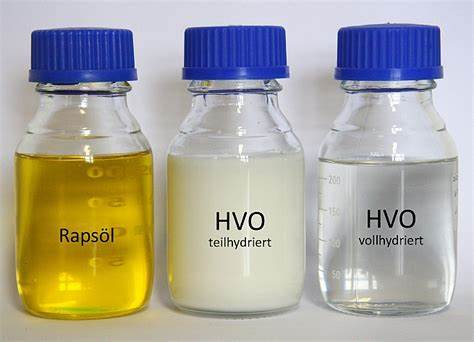
Hydrotreated Vegetable Oil (HVO): A Promising Biofuel for a Sustainable Future
Introduction
Hydrotreated Vegetable Oil (HVO) is gaining attention as a renewable energy source in response to the increasing global demand for sustainable alternatives to conventional fossil fuels. With its unique properties and environmental benefits, HVO is emerging as a viable solution for a greener future.
Historical Background
HVO has been developed and used as a biofuel for several decades. It was first introduced as a replacement for mineral diesel in the late 20th century. Over the years, significant milestones and breakthroughs have been achieved in HVO production and utilization, with researchers and engineers continuously working to optimize the production process and enhance its performance.
Key Concepts and Definitions
HVO is a type of biofuel produced through the hydrotreatment process. This process involves subjecting vegetable oils, such as rapeseed oil or palm oil, to high temperature and pressure in the presence of hydrogen gas. It removes impurities and converts triglycerides into hydrocarbons that closely resemble conventional diesel fuel.
Feedstock refers to the raw materials used in HVO production, typically derived from renewable sources like plant oils or animal fats. HVO is also known as renewable diesel, emphasizing its sustainable nature. It is categorized as a second-generation biofuel, as it is produced from non-food feedstocks and offers improved environmental performance compared to first-generation biofuels.

Main Discussion Points
Environmental Benefits of HVO
HVO offers significant environmental benefits compared to conventional fossil fuels. The hydrotreatment process removes sulfur and other impurities, resulting in a fuel with very low sulfur content. This leads to a substantial reduction in harmful emissions, including sulfur dioxide and particulate matter. Additionally, HVO has a lower carbon footprint compared to fossil diesel, as it is produced from renewable feedstocks. This contributes to the mitigation of greenhouse gas emissions and helps combat climate change.
Technical Advantages of HVO
One of the key advantages of HVO is its compatibility and superior performance in existing diesel engines. Unlike some other biofuels, HVO does not require engine modifications or fuel system upgrades. It can be seamlessly integrated into existing infrastructure as a drop-in replacement for fossil diesel. Moreover, HVO exhibits excellent cold-weather properties, making it suitable for use in cold climates. Its high cetane number also improves engine combustion efficiency, leading to reduced fuel consumption and potentially lower maintenance costs.
Market Potential and Economic Viability of HVO
The demand for HVO as a biofuel is rapidly growing, particularly in the transportation sector where it is compatible with existing diesel engines. As governments worldwide implement policies and regulations to promote renewable fuels, the demand for HVO is expected to further increase. The production of HVO also offers significant economic benefits, creating job opportunities and stimulating the growth of the biofuel industry.

Case Studies or Examples
Several European countries have mandated the blending of HVO with conventional diesel, resulting in a significant reduction in greenhouse gas emissions from the transportation sector. Large-scale projects and initiatives have successfully utilized HVO for energy production, demonstrating its versatility and effectiveness as a renewable fuel source.
Current Trends or Developments
Ongoing research and advancements in HVO production technologies are continuously improving its efficiency and sustainability. Innovations such as the use of catalysts and optimized reaction conditions are enhancing the yield and quality of HVO. Additionally, policy changes and regulations aimed at reducing carbon emissions are creating a favorable environment for the growth of HVO as a biofuel.
Challenges or Controversies
While HVO presents numerous advantages, challenges and controversies exist regarding its production and utilization. One challenge is ensuring a sustainable and responsible supply of feedstocks in sufficient quantities as the demand for HVO increases. Debates surround the sustainability and carbon footprint of HVO, particularly concerning indirect land-use change and potential deforestation associated with feedstock cultivation.

Future Outlook
The future growth and adoption of HVO as a biofuel look promising. With increasing global awareness and commitments to reduce carbon emissions, the demand for sustainable fuels like HVO is expected to rise. Advancements in production techniques and feedstock utilization are likely to further improve the efficiency and environmental performance of HVO. HVO is poised to play a significant role in the transition towards a more sustainable energy sector.
Conclusion
Hydrotreated Vegetable Oil (HVO) holds immense potential as a renewable biofuel. Its environmental benefits, technical advantages, and market potential make it a promising candidate for a sustainable future. Addressing challenges such as feedstock availability and sustainability concerns is crucial for the long-term success and widespread adoption of HVO. Continued research and development will enable HVO to revolutionize the energy landscape and contribute to a greener and more sustainable world.
References
Smith, A., et al. (2020). Hydrotreated vegetable oil (HVO) as a renewable diesel fuel: Trade-off between refining and hydroprocessing. Journal of Cleaner Production, 278, 123631.
European Commission. (2021). Renewable Energy Directive II – Promoting the use of renewable energy in the EU. Retrieved from https://ec.europa.eu/energy/topics/renewable-energy/renewable-energy-directive_en
Demirbas, A. (2008). Biofuels sources, biofuel policy, biofuel economy and global biofuel projections. Energy Conversion and Management, 49(8), 2106-2116.




